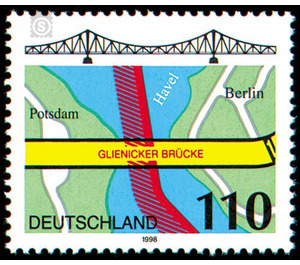bridges - Germany / Federal Republic of Germany 1998 - 110 Pfennig
Theme: Architecture
| Country | Germany / Federal Republic of Germany |
| Issue Date | 1998 |
| Face Value | 110.00 |
| Color | multi-colored |
| Perforation | K 14:13 3/4 |
| Printing Type | Multicolor offset printing |
| Stamp Type | Postage stamp |
| Item Type | Stamp |
| Chronological Issue Number | 1840 |
| Chronological Chapter | GER-BRD |
| SID | 457771 |
| In 42 Wishlists | |
The »Bridges« series marks the beginning of a series of bridges in Germany, which will unveil striking examples in a relaxed series under the motto »Connecting Bridges«. The Glienicker bridge is located in the extreme southwest of Berlin on the running in the middle of the Havel border between Berlin and Potsdam. The original wooden construction was part of the connection between Berlin and Potsdam built by Friedrich Wilhelm II in 1795 to form the first weatherproof road in Prussia. Due to the growing traffic it had become necessary in 1834 to build a broader and more massive stone bridge based on designs by Karl Friedrich Schinkel. By the beginning of the 20th century, the bridge was replaced by an even wider and higher steel structure. It was now to be called "Kaiser-Friedrich-Brücke", but the name did not prevail. The bridge was destroyed in the last days of the war of World War II. It was to be handed over to traffic after its reconstruction on 19 December 1949 by a solemn act. The then Land Brandenburg took the decision that from then on the bridge should be called the "bridge of unity" as a contribution to the promotion of the unity of Germany. Contrary to this provision, the Ministry of Interior of the Soviet occupation zone had the bridge blocked on 26 May 1952 for general traffic; it was kept open to and from Potsdam only for Allied traffic. When, on 10 November 1989, the press reported: "At 18.00 o'clock the border crossing - Glienicke Bridge - was opened", it still became the "bridge of unity". (Text: Press and Information Office of the State of Berlin)


